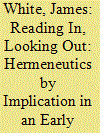|
|
|
Sort Order |
|
|
|
Items / Page
|
|
|
|
|
|
|
| Srl | Item |
| 1 |
ID:
177050


|
|
|
|
|
| Summary/Abstract |
Using newly discovered materials, this article introduces readers to the career and poetry of Mir Zeyn al-Din ʿEshq, a now forgotten poet who was connected to many prominent political and literary figures in India during the eighteenth century. The primary source for the research is John Rylands Library, Persian MS. 219, a holograph copy of the poet’s divān, which he presented to John Macpherson, acting Governor-General of the Presidency of Fort William, in May 1785. The divān contains a considerable amount of contextual commentary which allows us to reconstruct Mir Zeyn al-Din’s biography and working practices, casting light on how his verse was produced and consumed. An Iranian émigré, he circulated throughout the Punjab, North India and Bengal, accompanying the Afghan ruler Ahmad Shāh Dorrāni on his Indian campaigns, participating in professional symposia with some of the leading literary personages of Delhi, Lucknow and Patna, and entering the ambit of colonialist British patrons in Kolkata.
|
|
|
|
|
|
|
|
|
|
|
|
|
|
|
|
| 2 |
ID:
168993


|
|
|
|
|
| Summary/Abstract |
This article investigates aspects of mise-en-page in British Library Add. MS. 27261, an anthology of twenty-three texts on mixed subjects produced for Eskandar Soltān (d. 818/1415), grandson of Timur and self-styled ruler of territories in southern Iran during the early fifteenth century. It examines the juxtaposition of literary and scientific texts together with images in Add. MS. 27261, and explores the correlations that these juxtapositions create. It concludes that the London anthology should be seen as a coherent intellectual enterprise, and as an interpretative project designed to feed Eskandar’s experiments with different forms of knowledge.
|
|
|
|
|
|
|
|
|
|
|
|
|
|
|
|
| 3 |
ID:
157843


|
|
|
|
|
| Summary/Abstract |
A considerable amount of scholarship has been produced on just over sixty paintings of humans and demons, many of which bear ascriptions to the unidentified artist Mohammad-e Siāh Qalam, and which are now mostly housed in albums H.2153 and H.2160 in the Topkapı Palace Library. Although methods of formal comparison have led to general agreement that the paintings can be dated to either the fourteenth century or the fifteenth, strikingly little attention has been paid to the question of what these images depict. This paper studies the paintings within the context of documentary, legal and literary material in Persian and Arabic, and identifies a set of common motifs shared between the Siāh Qalam paintings and a number of later images. While it has been supposed by several scholars that the paintings document life in a marginal geographical environment and faithfully reflect the practices of a syncretic culture, this paper suggests that they engage with a field of satirical ideas which were widespread in the Islamic world in the fourteenth and fifteenth centuries, and which parodied common types of behavior that were deemed by some observers to be illicit or absurd.
|
|
|
|
|
|
|
|
|
|
|
|
|
|
|
|
|
|
|
|
|